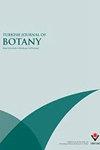DNA barcoding analysis and phylogenetic relationships of Indian wild coffee species
IF 1.5
4区 生物学
Q3 PLANT SCIENCES
引用次数: 3
Abstract
: Wild coffee species are the reservoirs of genetic diversity and could play a critical role in the genetic improvement of coffee. However, the conservation and genetic assessment of wild coffee species has been largely neglected. In the present study, DNA barcoding approaches were employed to assess the phylogenetic relationships between five indigenous wild coffee species from India and compared with two cultivated, and four wild coffee species of African origin. The efficacy of three barcoding loci namely matK , rbcL , and trnL-trnF was investigated using PCR amplification and sequence characterization. The intergenic spacer trnL-trnF is the highly polymorphic loci followed by matK and rbcL chloroplast gene. Among the three barcoding loci, the matK locus has the maximum number of parsimony informative sites, whereas the trnL-trnF locus contains maximum singleton variable sites. Although all the three loci contain a few unique fixed nucleotides (UFNs), no individual barcode locus has the critical nucleotide sequence tags for all the five Indian wild coffee species that help in species discrimination. However, the multilocus combinations are efficient in discriminating the species due to the presence of SNPs and specific sequence tags. The phylogenetic tree constructed using the maximum likelihood analysis of the combined barcoding loci separated all the Indian wild coffee species from African wild coffee species compared to phylogeny inferred using individual barcoding loci. Our study supports the utility of DNA barcoding as a useful tool for coffee species identification, which can be used for conservation purposes.印度野生咖啡种的DNA条形码分析及系统发育关系
野生咖啡是遗传多样性的储存库,在咖啡遗传改良中发挥着重要作用。然而,野生咖啡品种的保护和遗传评价在很大程度上被忽视。在本研究中,采用DNA条形码方法评估了来自印度的五种本地野生咖啡物种之间的系统发育关系,并与两种栽培咖啡和四种非洲野生咖啡物种进行了比较。采用PCR扩增和序列鉴定的方法研究了三个条形码位点(即matK、rbcL和trnL-trnF)的有效性。基因间间隔序列trnL-trnF是高度多态性位点,其次是matK和rbcL叶绿体基因。在三个条形码位点中,matK位点具有最多的简约信息位点,而trnL-trnF位点具有最多的单变量位点。虽然这三个位点都包含一些独特的固定核苷酸(ufn),但没有一个单独的条形码位点具有所有五种印度野生咖啡物种的关键核苷酸序列标签,有助于物种区分。然而,由于存在snp和特定的序列标签,多位点组合在区分物种方面是有效的。与使用单个条形码位点推断的系统发育相比,利用组合条形码位点的最大似然分析构建的系统发育树将所有印度野生咖啡物种与非洲野生咖啡物种分离开来。我们的研究支持DNA条形码作为咖啡物种鉴定的有用工具的效用,它可以用于保护目的。
本文章由计算机程序翻译,如有差异,请以英文原文为准。
求助全文
约1分钟内获得全文
求助全文
来源期刊

Turkish Journal of Botany
PLANT SCIENCES-
CiteScore
2.90
自引率
5.60%
发文量
31
审稿时长
6-12 weeks
期刊介绍:
The Turkish Journal of Botany is published electronically 6 times a year by the Scientific and Technological Research Council of Turkey (TÜBİTAK) and accepts manuscripts (in English) covering all areas of plant biology (including genetics, evolution, systematics, structure, function, development, diversity, conservation biology, biogeography, paleobotany, ontogeny, functional morphology, ecology, reproductive biology, and pollination biology), all levels of organisation (molecular to ecosystem), and all plant groups and allied organisms (algae, fungi, and lichens). Authors are required to frame their research questions and discuss their results in terms of major questions in plant biology. In general, papers that are too narrowly focused, purely descriptive, or broad surveys, or that contain only preliminary data or natural history, will not be considered (*).
The following types of article will be considered:
1. Research articles: Original research in various fields of botany will be evaluated as research articles.
2. Research notes: These include articles such as preliminary notes on a study or manuscripts on the morphological, anatomical, cytological, physiological, biochemical, and other properties of plant, algae, lichen and fungi species.
3. Reviews: Reviews of recent developments, improvements, discoveries, and ideas in various fields of botany.
4. Letters to the editor: These include opinions, comments relating to the publishing policy of the Turkish Journal of Botany, news, and suggestions. Letters should not exceed one journal page.
(*) 1. Raw floristic lists (of algae, lichens, fungi, or plants), species descriptions, chorological studies, and plant sociology studies without any additional independent approaches.
2. Comparative morphology and anatomy studies (that do not cover a family, tribe, subtribe, genus, subgenus, section, subsection, or species complexes with taxonomical problems) without one or more independent additional approaches such as phylogenetical, micromorphological, chromosomal and anatomical analyses.
3. Revisions of family, tribe, genus, subgenus, section, subsection, or species complexes without any original outputs such as taxonomical status changes, IUCN categories, and phenological and ecological analyses.
4. New taxa of all plants without any additional independent approaches such as phylogenetical, ecological, chromosomal, chorological and correlational analyses in addition to a detailed macro- and micro-morphological descriptions with quality field and microscopic illustrations of taxonomically important structures and identification key in the taxonomic group.
New records of all plants without any additional independent approaches such as phylogenetical, ecological, chromosomal, chorological and correlational analyses in addition to a detailed macro- and micro-morphological descriptions with quality field and microscopic illustrations of taxonomically important structures and identification key in the taxonomic group may be accepted for peer review if they contain 3 or more new records or taxonomical status update, such as lectotypification, new combinations, transfers, revivals and synonyms.
5. New taxa of algae, lichens, and fungi without any additional independent approaches such as phylogenetical, ecological, chromosomal, chorological and correlational analyses in addition to a detailed macro- and micro-morphological descriptions with quality field and microscopic illustrations of taxonomically important structures and identification key in the taxonomic group.
New records of algae, lichens, and fungi without any additional independent approaches such as phylogenetical, ecological, chromosomal, chorological and correlational analyses in addition to a detailed macro- and micro-morphological descriptions with quality field and microscopic illustrations of taxonomically important structures and identification key in the taxonomic group may be accepted for peer review if they contain 5 or more new records or taxonomical status update, such as lectotypification, new combinations, transfers, revivals and synonyms.
 求助内容:
求助内容: 应助结果提醒方式:
应助结果提醒方式:


